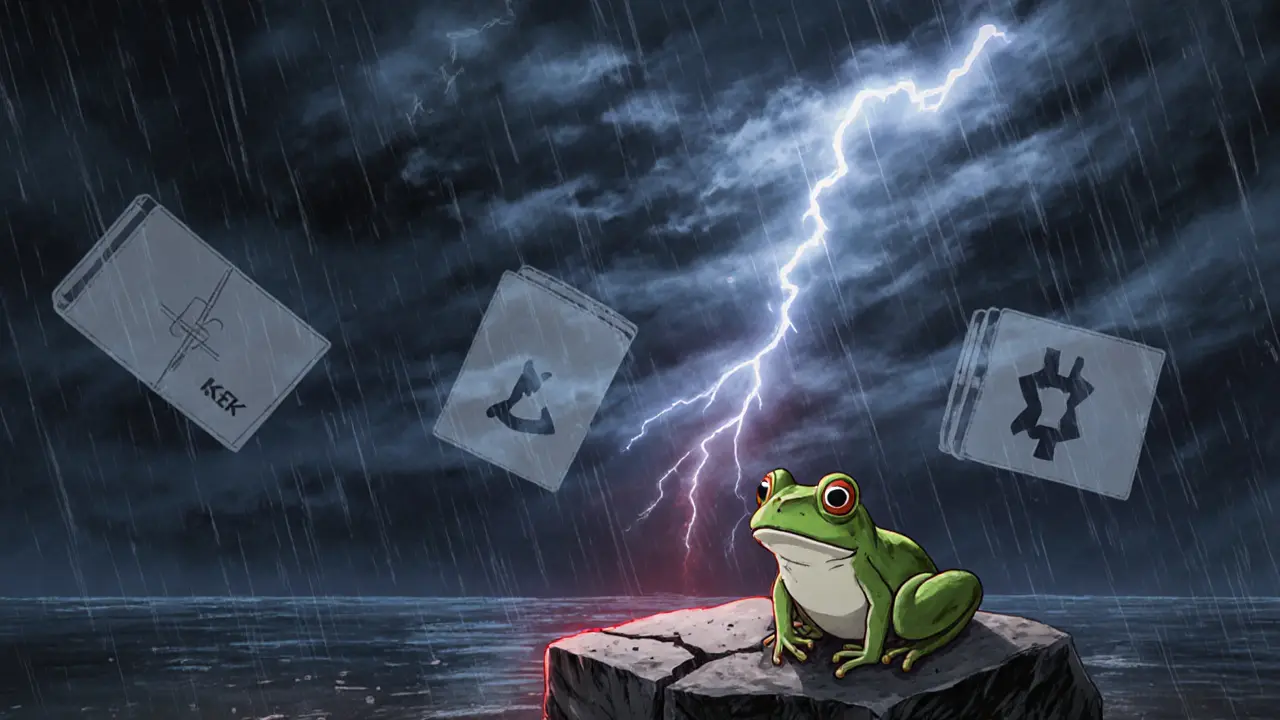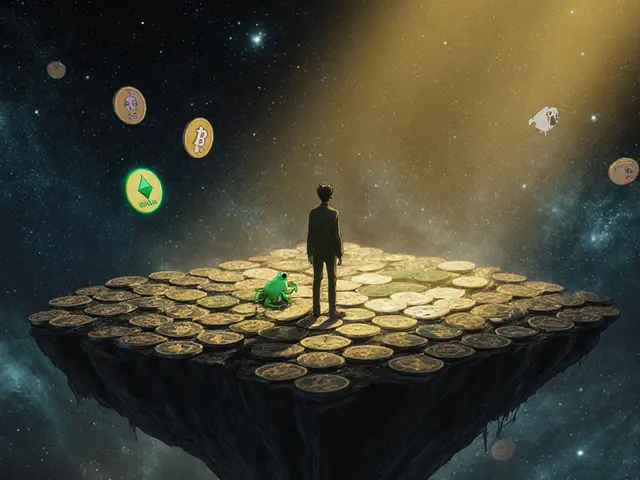Key Takeaways
- The KEK crypto is a frog‑themed meme token launched in early 2023 on Ethereum.
- It has a fixed supply of 77.78 trillion tokens, with over 95% locked in a liquidity pool.
- Trading volume is extremely low -often under $10 USD a day- making price manipulation easy.
- No official team, no whitepaper, and no listings on major exchanges; you need a Web3 wallet and a DEX to trade.
- Because of the ultra‑low liquidity and speculative nature, KEK is suitable only for experienced traders who can afford total loss.
What Is KEK (KEKE)?
When you hear about KEK (KEKE) a meme cryptocurrency built on the Ethereum blockchain, the first thing to know is that it blends ancient Egyptian folklore with the modern "Cult of Kek" meme culture that grew on 4chan and Twitch. The token’s mascot, a cartoon frog named “Keke The Frog,” refers to the frog‑headed deity Kek, symbolizing chaos and meme magic. Launched in early 2023, KEKE was never accompanied by a formal development team or a detailed whitepaper, positioning itself as a community‑driven experiment rather than a serious protocol.
Tokenomics at a Glance
Tokenomics defines how many coins exist, who holds them, and what incentives are built in. KEKE’s numbers are straightforward but extreme:
| Metric | Value |
|---|---|
| Total Supply | 77,777,777,777,777 (≈77.78 trillion) |
| Circulating Supply | 74.28 trillion (≈95% of total) |
| Liquidity Allocation | 92.3 % locked in Ethereum liquidity pool (LP tokens burned) |
| Reserve Allocation | 7.7 % held in a multi‑signature wallet for future exchange listings |
| Buy/Sell Tax | 0 % (no transaction fees) |
The heavy‑weight liquidity lock is meant to signal “no rug pull,” but the reality is that such a massive pool with near‑zero daily volume can be drained or price‑warped by a single large trade.

Market Position and Price History
KEKE trades on a handful of decentralized exchanges (DEXes) like Uniswap. Its price hovers around $0.00000000675 USD, with 24‑hour volumes ranging from a single dollar to about $70,000 on rare spikes. By contrast, established meme coins such as Dogecoin sit at a market cap of billions of dollars. KEKE’s market‑cap ranking is typically beyond the top 5,000, often reported as $0 due to the minuscule per‑token value.
Technical analysis is practically impossible - most charting platforms show “NaN” for RSI, MACD, and moving averages because the trade data is too sparse. Analysts from CoinCodex forecast a modest decline to $0.00000000858 by the end of 2025, while the Fear & Greed Index sits in a neutral range (52‑55). In plain terms, the token’s price moves more on speculation than on any fundamental development.
How to Acquire KEKE
If you decide to experiment with KEKE, you’ll need a Web3 wallet and a bit of Ethereum gas money. Here’s a step‑by‑step rundown:
- Install MetaMask (or another Ethereum‑compatible wallet) as a browser extension or mobile app.
- Buy a modest amount of ETH on a mainstream exchange (Coinbase, Binance, etc.) and transfer it to your wallet.
- Visit Uniswap, click “Connect Wallet,” and paste KEKE’s contract address
0xf7168c8AbB0ff80116413a8d95396BBdC318A3fF. - Enter the amount of ETH you want to swap, confirm the transaction, and pay the gas fee (typically $1.50‑$3.00 on Ethereum as of Oct 2025).
- After the transaction confirms, add KEKE as a custom token in MetaMask to see your balance.
Because KEKE isn’t listed on centralized exchanges like Coinbase or Binance, you will likely have to hold the token in an external wallet indefinitely. Exiting the position can be painful when liquidity dries up - you may end up paying more in gas than the token’s worth.

Risks and Red Flags
Every crypto investor knows to watch for red flags. KEKE stacks up with a hefty checklist of warnings:
- Ultra‑low liquidity - daily volume often under $10, making price swings extreme.
- No documented development team or roadmap, meaning there’s no accountability.
- Smart contract is renounced, so any future upgrades are impossible - you’re stuck with the code as‑is.
- Potential regulatory scrutiny: the SEC has recently targeted low‑liquidity tokens as possible securities.
- High probability of total loss - a study by CryptoRank found 92 % of tokens with sub‑$10K volume disappear within 18 months.
If you’re new to crypto, treat KEKE as a “play money” experiment rather than a serious investment.
Community, Development, and Future Outlook
The KEKE community is practically nonexistent. There’s no official Discord, Telegram, or Reddit hub with regular activity. The project’s website only lists a vague roadmap: “secure listings on centralized exchanges.” As of October 2025, no exchange has announced a listing, and the multi‑signature wallet holding 7.7 % of supply remains idle.
Comparatively, other frog‑themed meme tokens like Polkafrog have achieved modest market caps ($187 K) and some exchange presence. KEKE’s lack of utility, community, and liquidity suggests it will stay in the “extreme low‑cap” niche unless a surprise partnership occurs.
Should You Consider KEKE?
Bottom line: KEKE is a speculative meme token that offers a fun narrative but no real utility. If you’re comfortable with total loss, have spare ETH for gas, and enjoy hunting obscure tokens, you might allocate a tiny fraction of your portfolio (e.g., <1 %). For anyone seeking stable returns, long‑term holdings, or real-use blockchain projects, skip KEKE and look at established assets.
What does the acronym KEK stand for?
KEK doesn’t stand for a formal phrase; it references the ancient Egyptian frog‑god Kek and the internet “Cult of Kek” meme, combining mythology with modern meme culture.
Which blockchain does KEKE run on?
KEKE is an ERC‑20 token on the Ethereum blockchain.
How can I buy KEKE?
You need an Ethereum‑compatible wallet (e.g., MetaMask), some ETH for gas, and access to a decentralized exchange like Uniswap. Add KEKE’s contract address 0xf7168c8AbB0ff80116413a8d95396BBdC318A3fF to the DEX and swap ETH for KEKE.
Is KEKE a good long‑term investment?
Given its tiny liquidity, lack of development roadmap, and high regulatory risk, KEKE is not recommended for long‑term holding. It’s a high‑risk speculative token.
What are the main risks of trading KEKE?
Risks include extreme price volatility, near‑zero daily volume, inability to exit positions without losing gas fees, potential regulatory action, and the chance of the token becoming entirely illiquid.



Richard Williams
October 26, 2025 AT 07:14Hey folks, if you’re thinking about dipping a toe into KEK, treat it like a high‑risk experiment rather than a portfolio staple. The token’s ultra‑low liquidity means even a modest trade can swing the price dramatically. Make sure you only allocate money you can afford to lose, and keep a healthy portion of ETH handy for gas fees. Diversify your exposure elsewhere and use KEK strictly for fun or learning purposes. Stay aware of the red‑flags and keep your overall risk budget in check.
adam pop
November 4, 2025 AT 13:40The whole KEK situation feels like a playground for hidden puppeteers. With 95% of supply locked in a single liquidity pool, a single whale could pull the rug without anyone noticing. The fact that the contract is renounced only adds to the mystery – there’s no way to tweak or fix anything if something goes wrong. I wouldn’t be surprised if the token is a front for laundering small amounts of cash under the guise of meme culture. Stay far away unless you’ve got a conspiracy‑theory radar turned on full blast.
Dimitri Breiner
November 13, 2025 AT 19:53Listen up, KEK is a classic example of a meme token that thrives on hype, not fundamentals. The community is practically non‑existent, which means you won’t get any support or development updates. If you do decide to buy, do it with a clear exit strategy – set a profit target and a stop‑loss, even if those concepts feel weird in such low‑volume markets. Remember, the only real value here is the thrill of hunting obscure tokens, not long‑term growth.
LeAnn Dolly-Powell
November 23, 2025 AT 02:06I get the excitement around KEK – it’s got that fun frog meme vibe! 🎉 If you’re just looking to experiment and have some spare ETH for gas, it can be a quirky side project. Just keep expectations realistic and remember that the token could disappear overnight. Stay positive, but stay vigilant! 🌟
Rohit Sreenath
December 2, 2025 AT 08:20It’s a bad idea.
Sam Kessler
December 11, 2025 AT 14:33From a macro‑economic perspective, KEK epitomizes the pathological externalities inherent in hyper‑speculative, low‑liquidity altcoin ecosystems. Its tokenomics-77.78 trillion units with a 92.3% immutable liquidity lock-constitutes a classic case of capital misallocation, where systemic risk is amplified by a paucity of market depth. The absence of a development roadmap or governance structure renders any prospective utility moot, relegating the token to a stochastic asset class governed solely by anecdotal meme velocity. Moreover, the renounced smart contract architecture precludes post‑deployment patching, effectively fossilizing the protocol in a static, potentially vulnerable state. The resultant price discovery mechanism is distorted, as even infinitesimal transaction volumes can precipitate price slippage of several orders of magnitude, undermining any semblance of price efficiency. Institutional investors will invariably shun such an instrument due to regulatory ambiguities, especially given the SEC’s heightened scrutiny of low‑volume securities. Consequently, the token’s market cap-often reported as negligible-fails to reflect any intrinsic value beyond speculative novelty. In the broader cryptoeconomic discourse, KEK serves as a cautionary exemplar of token proliferation without meritocratic underpinnings, thereby inflating the overall noise-to-signal ratio within decentralized finance. Those seeking exposure to genuine innovations should divert capital toward projects with transparent governance, verifiable code audits, and demonstrable utility. To summarize, KEK is an archetypal meme token that offers entertainment at the expense of financial prudence, and its inclusion in a diversified portfolio is, at best, a marginal hedge against meme‑driven volatility.